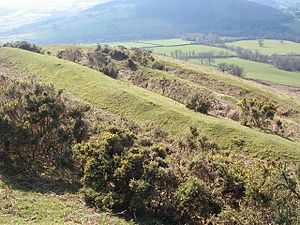Pen-y-crug facts for kids
Pen-y-crug is a hill located in the Brecon Beacons National Park in Powys, south Wales. People living nearby often call it 'The Crug' (pronounced cree-g). Its Welsh name means 'top of the mound'.
The hill has gentle slopes on most sides. Only the western side is a bit steeper. At the top, there is a flat area with a trig point, which is a marker used for surveying. This summit is 331 meters (about 1,086 feet) high. From the top, you can see the River Usk valley to the south. You can also enjoy wide views of Brecon to the southeast. To the east, you will see the Black Mountains, and to the south, the main Brecon Beacons range.
What is Pen-y-crug Made Of?
The hill is mostly made of sandstones and mudstones. These rocks are part of the St. Maughans Formation. They were formed during the Devonian period, which was a very long time ago. These rocks are also known as the Old Red Sandstone.
The lower parts of the hill have different rocks. These are mudstones and sandstones from the Raglan Mudstone Formation. They are even older, from the late Silurian age. You can find some old, unused sandstone quarries on the upper slopes. During the last ice age, it is thought that Pen-y-crug stood above the ice of the Usk Valley glacier.
How to Explore Pen-y-crug
There are several ways to explore Pen-y-crug. A bridleway goes over the northern and eastern sides of the hill. This path starts from the B4520 road near Brecon. It is a great route for walkers, horse riders, and mountain bikers.
A public footpath also leads to the top of the hill. This path starts from the edge of Brecon and passes by Maen-du Well. The higher parts of the hill are open access, which means walkers can explore freely. There is a small car park north of the hill. It is a good place to start your walk.
Discovering the Past at Pen-y-crug
The very top of Pen-y-crug has an amazing Iron Age hillfort. A hillfort is an ancient settlement that was built on a hill for protection. This one is very impressive and is one of many in the Usk Valley.
On the southeastern side of the hill, you can also find the remains of an old brick and tile factory. This factory was built during Victorian times, a long time ago.


